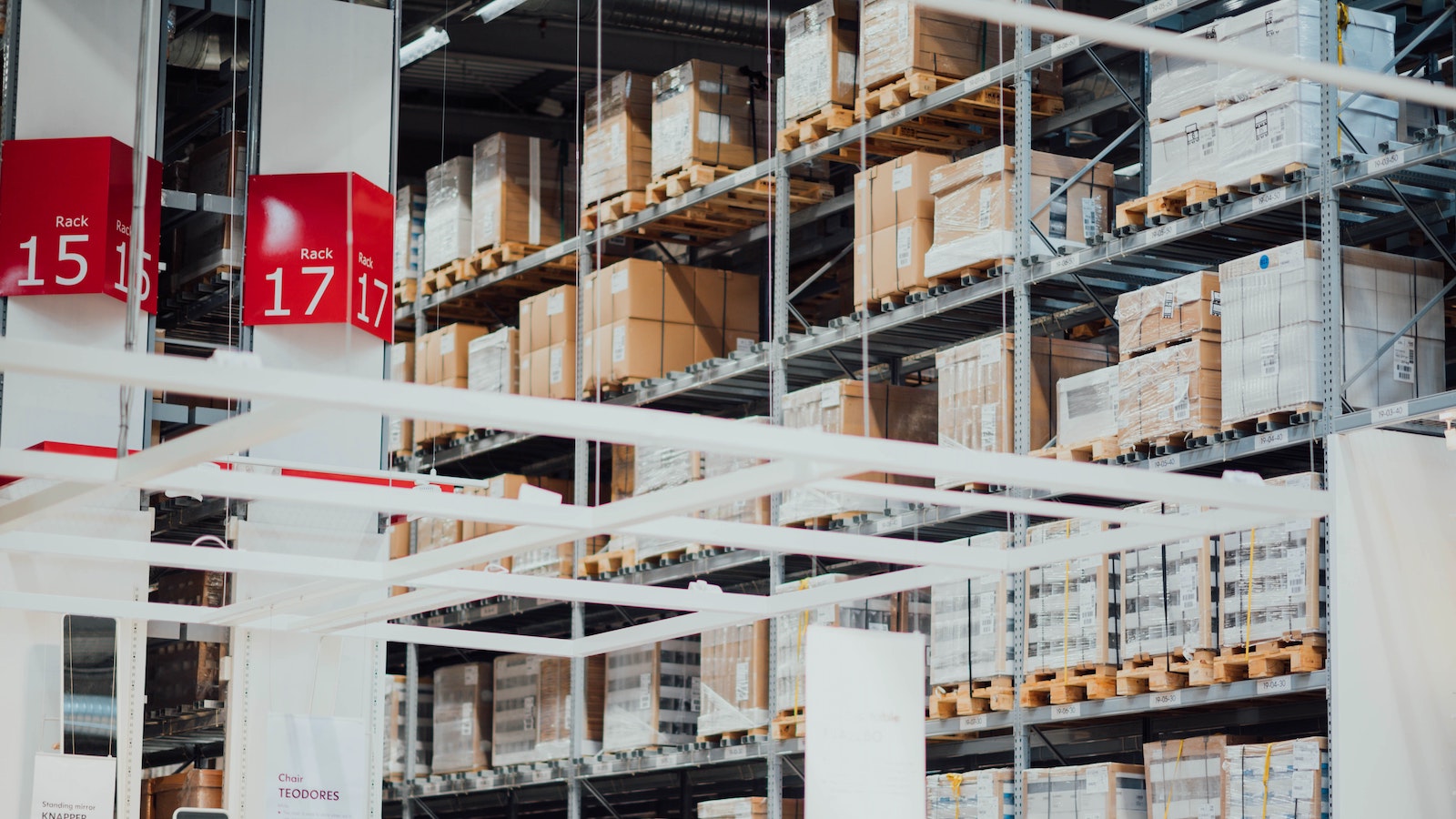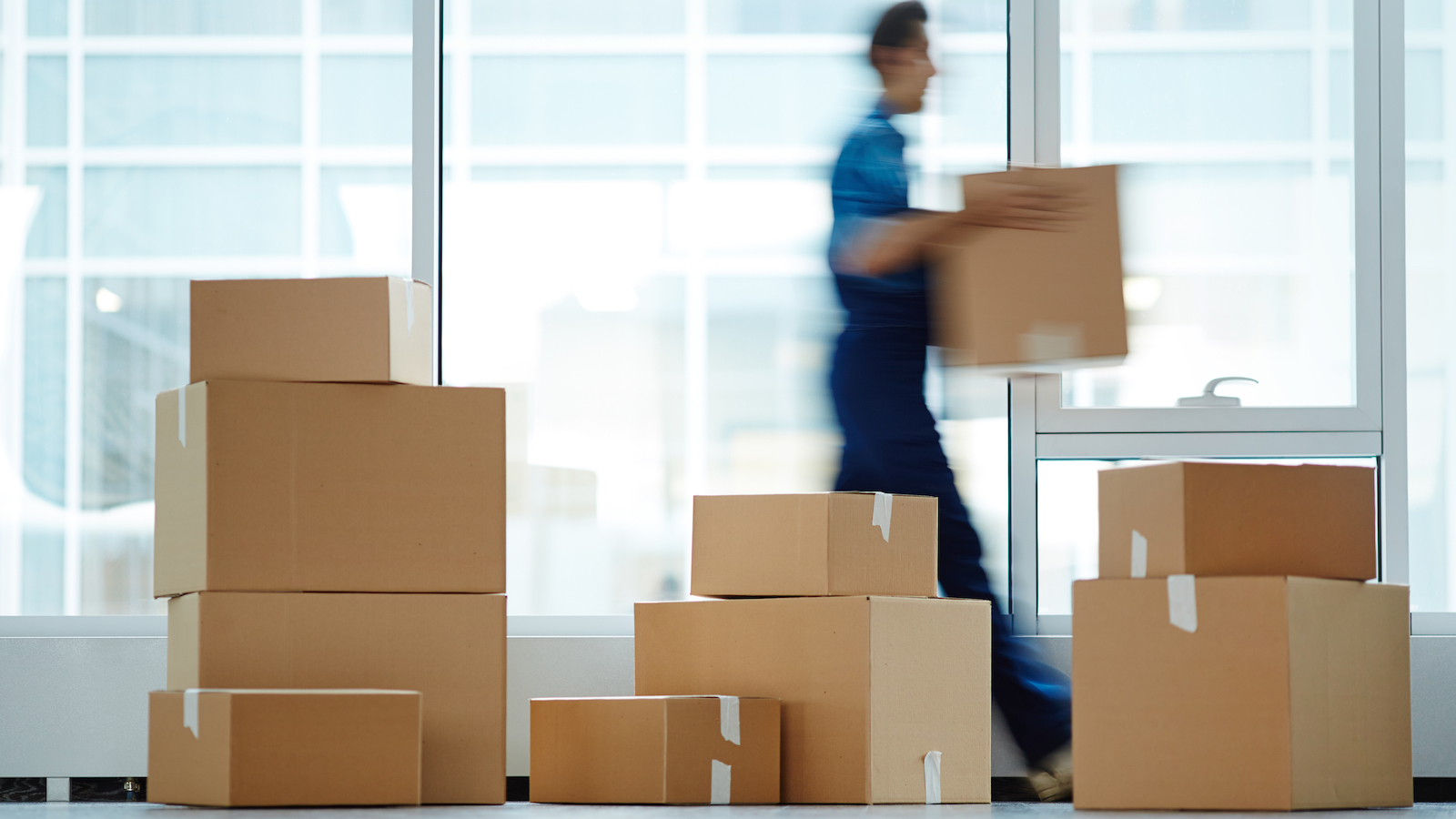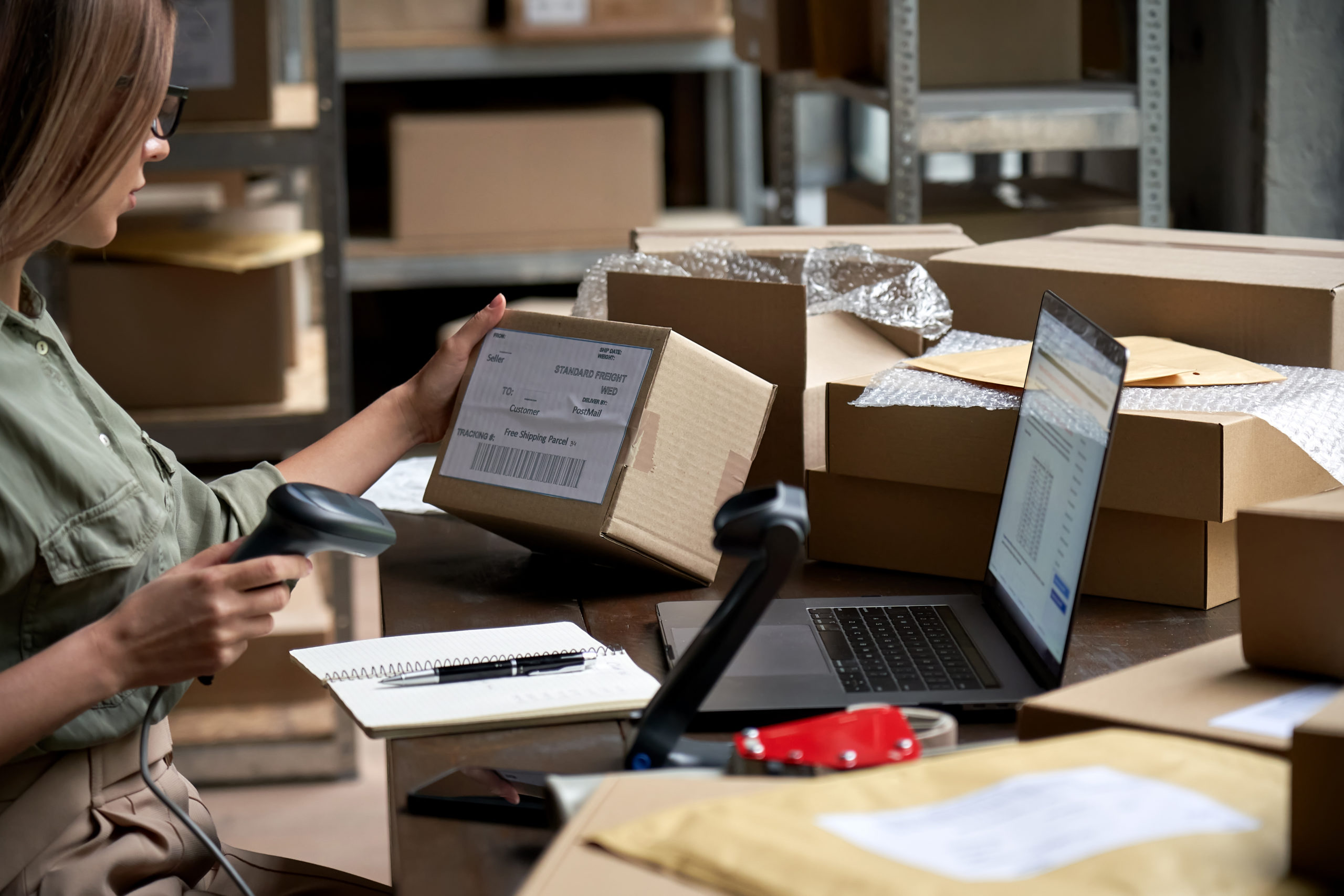Table of Contents
** Minutes
What do retail warehouses do exactly?
Common warehousing challenges growing retailers face
Warehousing solutions for growing brands
ShipBob’s warehousing solutions
While retail locations may be struggling to stay open following COVID-19, retail warehousing is more important than ever before.
Because of the boom in online retail sales and demand for contactless home delivery resulting from the pandemic, retailers are finding themselves in need of space to store inventory and fulfil orders efficiently.
They have had to get creative, with some renting a warehouse, others partnering with a 3PL (third-party logistics providers), and some even converting obsolete retail space into dark stores (micro fulfilment and/or distribution centres that are not open to shoppers).
However you secure it, retail warehousing is an absolutely critical aspect of modern business — especially as ecommerce industry growth continues to skyrocket. With the right strategy, operations, and investment, retail warehousing can transform online retail into a competitive advantage for your business, and position it for success in the digital marketplace.
In this article, we will focus on what retail warehousing is, why it’s important for retailers, how to implement retail warehousing in your supply chain management, retail warehousing best practices, and what to look for in a retail warehouse.
What is retail warehousing?
Retail warehousing refers to the storage of a retailer’s goods and/or the fulfilment of online orders within a warehouse space.
Within the retail supply chain, retail warehousing is a very important step, as it directly affects the quality and efficiency of every supply chain activity after it. For example, if a retailer’s warehouse storage process is disorganized, it becomes difficult to keep track of what items are available and fulfilment slows; but if warehouse storage is tidy and optimised, then pickers can quickly pick and pack orders without worrying about stockouts.
Depending on how big a business is, warehousing can be done from one’s own home or store, through a rented or constructed warehouse space, or through a 3PL. Given the size of most retailers, renting a warehouse or partnering with a 3PL are usually the most plausible and cost-effective options.
What do retail warehouses do exactly?
Retail warehouses serve a critical purpose within the retail supply chain, and house many important operations and activities. Here are just some of the logistical functions for which retail warehouses are responsible.
Stores inventory
After a retail warehouse receives the inventory ordered from a manufacturer during procurement, that inventory must be organised and stored away.
This involves unloading each pallet of inventory, sorting it by type and SKY, and performing inventory counts to ensure that the amount of inventory ordered matches what was delivered, and to establish new inventory levels. That inventory is then moved inside the retail warehouse for storage.
Inventory storage should never be random or haphazard. Rather, a retail warehouse should be organised so that popular SKUs are closer to the ground to give pickers easy access, and give each SKU its own specific location, with different types of inventory separated from each other. Production inventory (or raw materials that have yet to be assembled into finished goods), for example, will need to be stored separately from finished goods ready to be picked.
Labelling each SKU with a unique barcode also helps keep retail warehouse storage organised. When a picker picks a unit and scans its barcode, it will automatically update that SKU’s inventory level on whatever inventory management software the retail warehouse uses.
Fulfills orders to customers
Retail warehouses will often double as fulfilment centres, meaning that the warehouse will not only store inventory before it is sold, but also serve as a space where orders are picked, packed, and prepared for shipping once a customer makes a purchase.
The process of order fulfilment is multifaceted. It begins with order processing and confirmation, where an order’s details are communicated (usually electronically or through an ecommerce platform) to a retail warehouse.
In that warehouse, the order is passed to a picker, who picks the order, packages it, and then sets it aside for shipping. That order then ships to the end customer’s doorstep through last-mileshipping couriers like UPS, USPS, or FedEx.
With so many moving parts to ecommerce fulfilment, it can be challenging to maintain order accuracy while driving speed and efficiency as well. To achieve this, different technologies — including your ecommerce platform, inventory management systems (IMS) and warehouse management systems (WMS) — must all work together seamlessly to confirm orders and track inventory. If not, order inaccuracies, supply chain breakdowns, and delays in delivery may threaten the customer experience.
“Our fulfilment is on autopilot. ShipBob saves us so much effort, and the opportunity cost savings has been substantial. I’ve been spending my time on business development and strategic partnerships, reaching out to retailers to see if they want our product on their shelves. Rather than us packing boxes and going to FedEx, or paying additional fees to another third-party, having ShipBob do it all is awesome.”
Yannick Crespo, Co-Founder & President of Pot d’Huile
Fulfills orders to retail stores
Unlike DTC or small business warehouses, retail warehouses have the added capability of fulfilling and shipping orders to retail locations, rather than to the customer’s doorstep.
DTC brands remove wholesalers or retailers from the equation, and choose to ship their finished goods straight from their warehouses to customers. Retailers, on the other hand, can ship orders both to consumers and to retail locations for order pickup.
Alternatively, a retail warehouse can also pick and ship particular inventory to various retail centres for restocking or redistribution purposes, so that physical stores will have enough on hand in a pinch.
Common warehousing challenges growing retailers face
Retail warehouses are necessary for scaling your business through online retail — but the more your business grows, the more complicated warehouse management becomes, and the more challenges you will face in your retail warehousing.
Here are just a few of the challenges retailers should expect to encounter in retail warehousing as their operations grow.
Increased order volume
As your retail business grows and order volume increases, you’ll need a retail warehouse and order fulfilment strategy that can keep up with the influx of orders.
If order volume increases and you don’t have the staff, storage space, or warehouse work flow to fulfil those orders accurately and on time, you won’t be able to meet your customers’ expectations.
This, in turn, discourages customers from making repeat purchases or results in costly returns you must process, both of which hurt your revenue.
Ideally, a retailer should take time to prepare their supply chain before a major growth period, to ensure that they have the floorspace, storage space, and optimised processes to support an influx of orders.
In cases of sudden, rapid, or unpredicted growth, it may be useful to partner with a 3PL. The right 3PL will have the capacity, resources, and expertise to successfully take on high order volumes that individual retailers may not be prepared for.
Inventory management
Higher order volumes mean that products are flying off the warehouse shelves at a faster rate — so growing retailers must be extremely careful to manage their inventory as they scale, and track inventory levels religiously to make sure that they are always in a position to meet customer demand.
For successful inventory management within a retail warehouse, retailers must:
- Obtain accurate inventory counts for each SKU
- Keep sufficient safety stock on hand in case of an emergency
- Forecast demand, taking into account new trends and seasonality, to order just enough of the right SKUs to meet customer demand and prevent amassing deadstock
- Time replenishment correctly to avoid stockouts and backorders while minimising holding costs
- Conduct regular inventory audits to reassess inventory levels and accounting practices
To automate inventory management, many retail warehouses employ inventory management software (or IMS). These systems provide real-time inventory levels, and automatically update inventory counts within minutes or even seconds to reflect orders.
Some tech-enabled 3PLs even utilise IMSs that include additional automations to help with reordering and inventory tracking, as an added benefit for their customers.
Poor technology
Outdated or incompatible technology is not of much help in a retail warehouse — in fact, it can actually inhibit a warehouse’s efficiency, instead of promoting it.
While it may be slightly better than performing warehousing operations and tracking inventory manually, poor technology with connectivity issues, complicated controls, or limited capabilities is not cut out to process increasingly large quantities of orders.
For a truly optimised retail warehouse, retailers need modern and intuitive technological tools to help them scale operations effectively.
Retailers should consider investing in the best hardware (such as barcode scanners and labels, robotics, and warehouse automations) as well as software (including a WMS and IMS). While it may be pricier up front, the long-term benefits of a smoother supply chain far outweigh the initial cost.
3PLs are masters of digital warehousing best practices, and some offer cutting edge technology platforms to help you manage inventory, optimise warehouse operations, and track important information.
ShipBob’s dashboard, for example, allows users to view real-time inventory counts, analyse the most cost-effective distribution of their inventory, and track key metrics to help forecast demand and maximise efficiency within their warehouses and supply chain.
“We are very impressed by ShipBob’s transparency, simplicity, and intuitive dashboard. ShipBob’s front-end software was the primary decision-making factor for me in choosing them over other fulfilment solutions.
Their software is so simple and intuitive, especially as so many 3PLs have either bad or no front-facing software, making it impossible to enter orders, keep track of what’s leaving or entering the warehouse. It’s fun to see orders shipping out instantaneously.
I love how fast and efficient ShipBob is. Their shipping costs are very reasonable, and their platform makes fulfilment feel so easy.”
Harley Abrams, Operations Manager of SuperSpeed Golf, LLC
Lack of expertise
Warehousing can be overwhelming for beginners during periods of normal demand — let alone while you’re trying to scale. If you are a small retailer, chances are that you don’t know the ins and outs of warehousing as well as other experts.
Without prior experience in warehousing, retailers risk overpaying for sub-par solutions, wasting time and money on preventable errors, and ineffectively planning logistics and other aspects of their business’s future.
It is here that the experience and industry knowledge of a 3PL can become a competitive advantage for retailers.
The right 3PL will streamline the process of operating a retail warehouse using SOPs that they have carefully cultivated, introduce vetted technology to improve supply chain efficiency, and serve as a resource for your retail business as it navigates challenges such as seasonal blockages, international shipping protocols (such as import duties, taxes, and customs), and last-mile logistics.
Warehousing solutions for growing brands
For retailers looking to prepare their businesses for the challenges above, there are a variety of warehousing solutions that they can implement. Here are 3 strategies that retailers can use to handle their retail warehousing, improve its efficiency, and support their business’s growth.
Third-party logistics
3PLs are not just for smaller, DTC brands. In actuality, larger retailers have much to gain by partnering with an experienced, tech-enabled 3PL.
Outsourcing to a 3PL gives large retailers access to the resources they need to scale their retail warehousing operations efficiently, without requiring them to invest in real estate or capital themselves.
For example, while storing inventory in one warehousing location may be economical for some retailers, distributing inventory across multiple warehouses can help reach geographically distant pockets of customers more cost-effectively.
Partnering with a 3PL that has already built an established network of storage and fulfilment centres across the country (preferably in more densely populated urban areas) is often the easiest way to accomplish this, as opposed to renting or buying multiple warehouses yourself.
This is just one type of optimisation that a logistics expert can provide. The right 3PL will be able to assess a retailer’s warehousing and identify areas for optimisation, as well as implementing operational improvements that minimise warehousing costs.
A 3PL also optimises for time. By outsourcing receiving, storage, fulfilment, and shipping to a 3PL, retailers spare themselves the hours of planning, coordinating, and executing logistics. As a result, there is time for retailers to focus on other important business functions, without sacrificing quality.
Warehouse management software
Warehouse management systems keeps warehouse processes streamlined, minimises mistakes in order fulfilment, tracks data to help analyse warehouse productivity, and automates different aspects of warehousing to save time and money.
While using a WMS is certainly no substitute for the hands-on, professional expertise of logistics service providers, more independent retailers looking to manage retail warehousing on their own should consider implementing a WMS to monitor daily warehouse operations and optimise where they can.
Logistics consulting
For retailers looking to keep everything in house, logistics consulting services can help optimise retail warehousing for cost and efficiency. However, these services can be quite expensive — so only sizable and/or well-established retailers will be able to afford it as a long-term solution.
ShipBob’s warehousing solutions
ShipBob is a tech-enabled 3PL that partners with retail and DTC businesses alike to provide Amazon-level logistics, including warehousing, storage, fulfilment, and shipping.
Whether you are a smaller business selling through retail channels or a larger retailer with a growing online presence, ShipBob offers solutions to help you handle your logistics. ShipBob is equipped with retail dropshipping, B2B, and multichannel retailing distribution capabilities, enabling you to reach more customers and have orders fulfilled regardless of where you sell.
ShipBob’s global fulfilment centre network includes dozens of warehouses and fulfilment centres throughout the US and in multiple countries, so that retailers can distribute their inventory between various locations and achieve 2-day shipping affordably.
Each one of these warehouses runs on ShipBob’s proprietary WMS, meaning that operations and fulfilment are uniform wherever you choose to store your inventory and fulfil your orders.
In every warehouse, ShipBob utilises warehousing best practices such as batch picking, optimised warehouse picking routes, automatic reorder point notifications, and warehouse receiving SOPs to optimise efficiency.
Retailers can keep tabs on warehouse operations using our dashboard, and use our analytics to analyse key data, forecast demand, and assess inventory distribution from one platform that connects directly with a retailer’s online store.
ShipBob also provides an integration ecosystem to help our customers find solutions for other issues in retail warehousing, such as returns management, freight management, and custom packaging design.
With these capabilities, ShipBob delivers best-in-class storage and ecommerce fulfilment services to retailers looking to take their retail warehousing strategy to the next level, and gives businesses the tools they need to scale.
For more information, request a pricing quote below and start the conversation.
Have your own retail warehouse?
ShipBob has a best-in-class warehouse management system (WMS) for brands that have their own warehouse and need help managing inventory in real time, reducing picking, packing, and shipping errors, and scaling with ease.
With ShipBob’s WMS, brands with their own warehouse can even leverage ShipBob’s fulfilment services in any of ShipBob’s fulfilment centres across the US, Canada, Europe, and Australia to improve cross-border shipping, reduce costs, and speed up deliveries.
Retail warehousing FAQs
Here are answers to the most common questions about retail warehousing.
Does ShipBob help with retail warehousing?
Yes! ShipBob offers omnichannel retail warehousing, from B2C fulfilment to B2B fulfilment and more. With various retail warehousing centres, ShipBob provides businesses with the support they need to have an omnichannel retail fulfilment strategy.
What makes retail warehouses different from normal warehouses?
There are few differences between retail warehouses and DTC warehouses. While they both receive and store inventory before it is picked, packed, and shipped, DTC warehouses ship orders directly to customers’ homes, whereas retail warehouses ship to both customers’ homes and retail store locations. In addition, some retail warehouses are dark stores, or unused retail centres have been converted into warehouse space, while this is uncommon for DTC warehouses.



